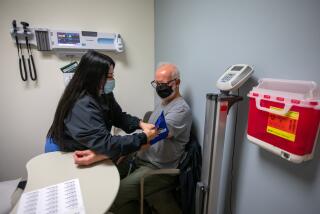Patient, protect thyself
The numbers can be worrisome -- 1 out of 10 hospitalized patients picks up an infection or suffers some kind of mistake while in the hospital, statistics show. And the stories are frightening -- Dennis Quaid’s newborn babies were given a huge overdose of a drug two months ago at a hospital with a top-notch reputation.
So what is a medical consumer to do? Should we all be afraid to go to the hospital?
It’s not quite that bad, say experts in medical quality and error prevention; hospitals these days are being held to higher standards. But, they add, there’s a long way to go on patient safety efforts. And consumers also have a role to play in keeping themselves safe -- asking questions, gaining a better understanding of how the healthcare system works, and more.
“There’s an assumption that the providers should have all the information and you should just take at face value what the provider tells you,” says Dr. Peter Angood, a trauma surgeon and vice president and chief patient safety officer for the Joint Commission, a national organization that accredits hospitals and other healthcare facilities. “One of the biggest things we can do in healthcare is to help patients understand that they need to be better consumers -- it’s good to question, to ask for clarification and solicit second opinions as needed.”
Here are some tips from organizations such as the Joint Commission and the federal Agency for Healthcare Research and Quality, which is charged with improving quality and safety of healthcare, on how to reduce the risk that you or a loved one will experience a medical error.
--
In the hospital
* Ask questions.
The best way to help your caregivers avoid mistakes is to talk to them. Many medical errors are related to medications -- getting the wrong drug or the wrong dose. A 2006 report by the Institute of Medicine on medical errors calculated, based on national data, that a hospital patient is subject to one medication error per day, on average. Medications most likely to be associated with errors, the report found, were insulin, morphine, potassium chloride, heparin and warfarin.
If you are in the hospital and being given a new drug or dose, ask the nurse what it is or why the dosage has been changed. If you don’t know why you are getting a medication, ask why.
The hospital may have a bar-coding system for medications that is meant to double-check by computer the patient’s name and drug dose against what the doctor ordered. (Currently, only 11% of California hospitals are fully using bar-coding technology for administering drugs, according to a January study by the nonprofit California HealthCare Foundation.)
If you have a bar code on your patient wristband, be sure it’s checked every time. Even if there’s no bar code, the caregiver should check your name.
* Vigilance is easier if you have someone else with you, particularly if you’re having surgery or are too sick to keep track of your own care. Try to have a support person there when you get checked in, when the doctor visits (most likely in the morning), before any major procedures and upon checkout.
“People need to watch out for their family members,” says Maribeth Shannon, director of the Market and Policy Monitor Program for the California HealthCare Foundation. “Often errors are caught because a family member says, ‘That doesn’t make sense to me.’ ”
If you are particularly concerned, have no one else to watch out for you or a relative and can afford it, consider hiring a patient advocate or private duty nurse to provide backup during key periods of a hospitalization. Some hospitals employ patient advocates to help sort out miscommunications. A registry of private-duty nurses available by the day may be available at your hospital. Private patient advocacy groups exist too. (Be warned: They can be pricey, and not all medical staff welcome involvement of a third party.)
Hospitals are becoming more open to support people in patient rooms and are even designing new hospitals with bigger rooms to accommodate more people, some even providing something to sleep on overnight.
* Keep close track of your medicines, including herbal or homeopathic remedies, supplements and over-the-counter drugs such as aspirin. And tell your caregivers what you’re taking. Some of these substances can interact negatively with one another -- ginseng, for example, interferes with the blood-thinner warfarin; chondroitin may cause excessive bleeding during surgery. A study assessing data from 21,000 U.S. adults in 2002 found that more than two-thirds of people using a supplement and a prescription medication in the same year did not tell their doctor about the supplement.
You can bring your current medications with you in a bag and have the doctor, nurse or pharmacist who visits your hospital room upon admission go over them and ensure that information about them is included in your hospital record. You’ll also want to be sure that a medical professional gives you advice about how to start taking any long-term medications again after hospitalization.
* Ask everyone who comes into your hospital room to wash their hands or use antibacterial lotion. Along with medication mistakes, the other complication most likely to occur from a hospital stay is getting an infection. Hospitals are germ factories, and there are some nasty, antibiotic-resistant bugs you really don’t want to take home with you.
Patients shouldn’t feel uncomfortable about requesting that people sanitize their hands -- many hospitals, in fact, put up posters reminding them to do so. In a study reported in 2001, 39 patients at a hospital in Oxford, England, agreed to ask all healthcare workers who were going to touch them to wash their hands. The result: an average 50% increase in hand-washing rates.
* If you’re having surgery, ask your surgeon what measures are in place at the hospital to prevent wrong-site surgery -- for example, having the wrong limb operated on. One of the hospital mistakes that gets the most attention, it is rare but does still happen despite a lot of bad publicity. (The Joint Commission has collected 615 reports of them since 1995.) Hospitals now commonly use some marking technique, such as having the patient sign the area to be operated on and repeatedly asking the patient which site is to go under the knife.
* Make sure your hospitalization is being overseen by one particular doctor, whether that’s your primary care doctor, a specialist or a hospitalist (a doctor who cares only for hospitalized patients).
--
At the doctor’s office
Although the big-ticket mistakes usually take place in the hospital, it’s also possible to have a mix-up at the doctor’s office. In a 2004 study of 15 family physicians in seven practices in the Cincinnati area, the physicians identified errors in 24% of 351 outpatient visits they later reviewed.
The doctors concluded that harm (albeit minor) was done to 18 patients, and potential harm to an additional 53 -- including physical discomfort, mild adverse drug reactions, moderate physical injury, progression of disease and (most commonly) emotional distress and wasted time.
* Make sure the doctor takes the time to hear what your symptoms and concerns are so the best diagnosis can be made.
* Ask questions and write down the answers. Have someone with you if it helps. Studies have shown that patients remember just a fraction of what their doctor says, particularly in cases of serious illness.
* Take a medication list to the doctor, particularly if you have several physicians. There’s no guarantee they’ll talk with each other or even read your record carefully, so it’s prudent to be sure each doctor is aware of your other treatment.
* If you get a handwritten prescription, make sure you can read it. If you can’t, the pharmacist may not be able to either. In a 1997 study at a hospital in Texas, six experienced nurses reviewed written medication orders by 36 doctors and found 20% to be illegible or legible only with effort. To avoid mix-ups, the doctor can also include on the slip the medical reason for the prescription.
--
At the pharmacy
* If you take a pill regularly and know what it looks like, open the bottle before you leave the pharmacy and double-check that it’s what your doctor wants for you. There are websites where you can check what a pill should look like, such as a pill identifier at www.drugs .com and www.lib.uiowa.edu /hardin/md/pillidentification .html.
* Just say “yes” to that talk with the pharmacist. He or she might help catch a prescribing mistake from the doctor. Pharmacists are required to answer your questions in a confidential area -- if your pharmacy doesn’t do this or seems too busy, find another. It’s useful to maintain a relationship with a single knowledgeable pharmacist who can track your care.
--
Do your homework
* If you have a choice about which hospital where you’ll be cared for, check out its safety record. Californians can go to CalHospitalCompare ( www.calhospitalcompare.org), put together by the California HealthCare Foundation, and check on a number of safety measures: other patients’ experiences, whether the hospital requires doctors to use computers to order drugs and treatments, and whether it has implemented 27 changes recommended by a health quality standards organization, the National Quality Forum, to reduce errors.
The website also reports on several high-risk treatments, such as coronary artery bypass and whether the hospital carries out enough of them to maintain high quality. (The measures come from surveys done by the Leapfrog Group, an employer coalition that promotes hospital safety and quality. On average, about half of hospitals complete the survey.)
The Joint Commission also maintains a website with hospital report cards that offer mortality rates, surgical infection rates and how well the hospital has met national patient safety goals (www.qualitycheck.org).
So far, however, efforts to provide the public with a simple “number of errors” rating for hospitals has not come to pass, and the report cards that are available today -- though better than nothing -- are limited in scope, experts say. Patients “should feel comfortable in learning as much as they can but not take it at face value,” Angood suggests. “They should be prepared to discuss it [with their doctor] and get reassurance about the kinds of effort going on” to reduce errors.
As the November heparin overdosing of three babies at Cedars-Sinai Medical Center shows, bad mistakes can happen even at hospitals that rate well on the report cards: Cedars-Sinai proudly lists its high ratings on patient safety from the Joint Commission and Leapfrog. The error happened in a way the infants’ parents couldn’t have known to ask about, during an internal handoff between the pharmacy and pediatric unit.
Patients need to remain vigilant to stay safe in an increasingly complex healthcare system. “I’m really reassured there’s so much attention now” on patient safety, Shannon says. “We’re safer in hospitals but not completely safe yet.”






